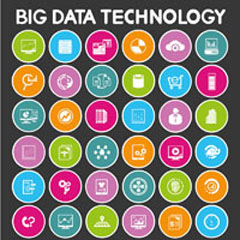Big Data & Business Analytics

POST GRADUATE PROGRAM IN BUSINESS ANALYTICS AND BIG DATA BY REPLACING “PGP – BIG DATA & BUSINESS ANALYTICS”
Why Business Analytics
1. The future – Industry have so much of data available now generated during the digitization phase in last 2 decades. Now is the time to utilize this data for executive management and strategic decision making.
2.Biggies like Tesco, Wal-mart, American Express, New York Stock Exchange etc have already Big Data implementation on the way.
3. McKinsey Global Institute’s Big data: The next frontier for innovation, competition, and productivity estimates that by 2018, “the United States alone could face a shortage of 140,000 to 190,000 people with deep analytical skills as well as 1.5 million managers and analysts with the know- how to use the analysis of big data to make effective decisions.
4. 90% of fortune 500 companies will have big data initiatives underway by end 2015.
Benefits of Big Data Analytics Course
1. Analytics using Big Data can be leveraged across all industries including Pharma, Telecom, Manufacturing, Retail, Health care, Public Sector Administration.
2. Estimate of over 2.5 lakh big data analytics jobs to be in there by mid 2015 in India alone.
3. Learn from the experts – We have engaged the best brains in the industry with a sea of practical and implementation experience in the field to give you the best available knowledge and share the real life case studies and experiences across different domains to prepare you for the real world.
4. Learn and understand the applicability of Big Data analytics using cross section of tools and technologies that can be used tomorrow.
Course Contents
Module 1 : Basics of Business Analytics & Business Mathematics
Module 2 : Predictive Analytics and Advanced Techniques
Module 3 : Business problem solving using advance analytics
Module 4 : Analytics in the age of Big Data
Module 5 : Big Data implementation across domains
Module 6 :Big Data Architecture
Module 7 : Data management using big data
Module 8:Benefits and business implementation of big data over the conventional
data management
The most Perfect Union: Unlocking the Next Wave of Growth by unifying Creativity and Analytics
For long, creativity could not be quantifiable. But now the best of marketers have realized that for innovation to be most successful, it needs to be backed up with reliable business analytics. For this, a lot of data warehousing needs to be done as well. Once that is done, the utilization of the same is a challenge. There are three levels of utilization. The base level are the Idlers, who use very little of this data for their marketing purposes. The next level consists of the Isolators. They do make use of data, but don’t integrate the same as part of the bigger picture. The top level is of the Integrators. These marketers not only use data, but also processes, that are then integrated. For them, data and creativity are equal partners. They use the agile marketing operational model. They also tap in to AI- driven consumer insights.
Source:https://www.mckinsey.com/business-functions/marketing-and-sales/our-insights/the-most-perfect-union
Uploaded Date:11 March 2020
Data- driven Cultures Start at the very Top
Businesses worldwide and even human societies are in the midst of a major transformation towards business analytics. This is being driven by several key factors, but two of them hold the greatest sway. The first is the sheer quantity of data warehousing, at an unprecedented high. The other includes the advances in technology. This factors in the cloud computing platforms, machine learning and artificial intelligence. In order to achieve success while using such technologies, it is also necessary to cultivate an analytical mindset among the employees. For this, one has to ensure that the top executives possess strong analytics capabilities. Routines too need be developed, which will actually give a boost to analytical thinking. The daily routines will power the long- term viability of these ideas.
Uploaded Date:27 February 2020
What Great Data Analysts Do- and why every Organization needs Them
Business analytics has now become so essential to every team, that data analysts are in high demand all over. A ‘full- stack’ data scientist is an elusive target for recruiters, with all seeking someone, expert simultaneously at statistics, analytics and machine learning. On the other hand, those who merely provide solutions on business intelligence or data mining have now been relegated to the periphery. However, what all need to realize is that the three sciences mentioned under the data scientist’s capability are all different to each other in substantial ways. Excellence in statistics requires rigor. Performance is the key to machine learning. For acing analytics, speed is of the essence. There is the major clause of depth versus width when it comes to pitching for all these, or looking for individual specialists. Analytics is thus needed for decision making and running AI, so there exist mass dangers of under- appreciating their adherents- the analysts.
Uploaded Date:23 December 2019
Kirk Borne on building Data Science Models
Data scientists have come up with a strategy to build the right model that captures data science. As a first step one needs to think big, yet start with small steps. The KISS principle or Keep It Short and Simple, needs to be followed. The 80- 20 Pareto Principle would also apply here. Another tip is to focus on finding the model, instead of building it. Of course, any such model, would require a through data warehousing operation, before anything could be concretely firmed up. Organizations need not lose sleep over failures. Instead, they must learn quick. The error rate needs to be checked for.
Source:https://www.boozallen.com/s/insight/blog/kirk-borne-on-building-data-science-models.html
Uploaded Date:21 December 2019
Winning with a Data- driven Strategy
A number of companies are now seeking to ace the competition using a data- centric business strategy. There are however, several barriers to this kind of transformation. In order to become data- driven, the company needs to align its data warehousing efforts, and subsequent analysis to the overall business agenda. For this, a data- driven culture too needs to be curated in place. Data- generated insights need to be made use of. The right technology and infrastructure need to be used, for all this to be fruitful. This includes a suite of analytical tools, for the right purposes. As data is the lifeblood of such digital- driven tasks, companies that have aced this game, will be best able to make us of its business analytics capabilities to generate the right insights.
Source:https://www.strategy-business.com/article/Winning-with-a-data-driven-strategy?gko=8f948
Uploaded Date: 12 December 2019
5 Myths of Big Data Platforms
There exist several myths surrounding the big data platforms. One of them is that if all the data sources are streamlined together, the most accurate of business insights may be procured. But this isn’t necessarily true, as several data sources just can’t be streamlined together due to the diverse policies, security requirements and related restrictions. Another myth is that with data all at one place, one can focus most on the business analytics. Instead, data needs to be stored on catalogue basis. The third myth is that industry technologies need to be used up. But more than the kind of technology, an agile structure is needed. People also believe in hoarding data, as more will apparently help us answer an increasing number of questions. In reality, it is about the quality of data and the tools being used, and not the extent of inputs available. The final myth is that there aren’t enough of data scientists to perform the tasks necessary for the analysis and intelligence gathering processes. Truth be said, more of capabilities need to be utilized by the data- driven solutions providers.
Source:https://boozallen.com/s/insight/blog/5-myths-of-big-data-platforms.html
Uploaded Date:24 October 2019
Removing Bias from Predictive Modeling
Predictive modeling and business analytics is of course supposed to be cold and unbiased. But it is an oxymoron to say that there are inherent biases that predictive modeling is laden with. This is because the data warehousing done, followed by the data set understood for analysis, is chosen as per human selection. This selection process is full of biases, unknown to many. A method has now been developed by a statistics professor. It specifically tackles the issue of race- based biases. Criminal justice for instance is one area where the use of algorithms needs some form of extra precaution now. These algorithms must be considered primarily for providing us the inputs, on which we may process out information.
Source:https://knowledge.wharton.upenn.edu/article/removing-bias-from-predictive-modeling/
Uploaded Date:14 October 2019


